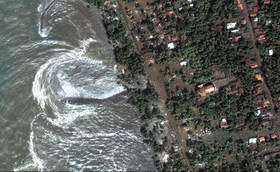Traces of a tsunami in Sweden

145 million years ago Scandinavia was hit by a tsunami, probably more intense than the one that hit Southeastern Asia in December 2004. Traces of this ancient tsunami are still left and these have been discovered by the geologists Vivi Vajda and Jane Wigforss-Lange at Lund University. The scientific results will soon be published in the journal Progress in Natural Science.
The site is located at Eriksdal, in the southernmost province of Sweden, Skåne. Scandinavia and the Baltic formed a continent 145 million years ago, around the Jurassic-Cretaceous transition. The coast line cut through Skåne and the area around Eriksdal was a delta environment. At this time Sweden was situated at the same latitude as the Mediterranean of today and the climate was globally warm, not even the poles were ice capped. In Scandinavia tree ferns, gingkoes and cycads were thriving and the fauna was dominated by dinosaurs. The coast was inhabited by sharks, crocodiles and tetrapods (now extinct giant amphibians).
The 30 metre thick section in Eriksdal is hid in a farmland and can only be accessed by extensive digging and the sediments are tilted so the layers are vertical. In the sediments we found fossils of fish, mussels, snails mixed with landplants, says Vivi Vajda. We first interpreted these beds as storm deposits but microscopical samples revealed a total mix of pollen, plant fragments and fungal spores both within the shellbed and just above, signs that indicate that material from land was transported by the same wave as the one causing the accumulation of the shell bed. Besides, the mussels and the snails were extremely well preserved indicating a single depositional event and not a storm, which would have left the shells broken and eroded. We started to suspect that a tsunami had hit the area but we didn’t have enough evidence at the time to put the theory forward.
But Vajda and Wigforss-Lange had found a probable cause for the tsunami. Norwegian scientists had in 1996 discovered a 145 million old crater at the bottom of Barents sea, North of Scandinavia. The crater was called the Mjölnir crater, named after the hammer which the god Thor used to fight giants with. The impact was catastrophic. It created a crater in the Mesozoic shelf of around 40 km in diameter and about 3.6 km deep and generated major shockwaves and tsunamis that travelled across the shelf. It is likely that tsunamis generated by this impact may have propagated southwards along the narrow intracontinental seaways affecting coastal areas in the Norwegian-Danish Basin, leaving such traces as the anomalous sequence recorded at Eriksdal.
The turning point for us was when we read the results published by a French research group, says Vivi Vajda. They studied sediments from the Boulonnais area in northern France which were deposited at the same time as the ones at Eriksdal and they interpreted the structures as tsunami deposits. Interestingly, this was put forward in 2000, at a time when tsunami wasn’t a concept in every man´s mind.
The 2004 Tsunami has attracted geologists from all over who want to learn more about the sedimentary structures that are left by tsunamis in order to interpret events in the past. In Indonesian Banda Acheh the tsunami left shells and other debris in depressions as it withdrew from the land. Usually there are also erosional contacts at the base of these beds where the tsunami has partly removed underlying sediments. Jane Wigforss-Lange, specialised in sedimentology also recorded these structures in the Swedish layers.
Source: The Swedish Research Council



















